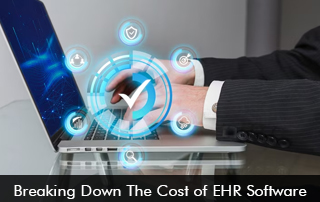Adopting electronic health records (EHR) software is essential to medical practices and it comes with a financial commitment. Therefore, understanding the real cost of EHR software is necessary to make financial decisions.
Understanding the Basics of EHR Software
Before we dive into the cost breakdown, it’s important to grasp what EHR software entails. EHR software, often used interchangeably with Electronic Medical Record (EMR) software, is a digital platform designed to store, manage, and exchange patient health information. These systems have evolved significantly in recent years, offering a wide range of features and capabilities to cater to the diverse needs of healthcare providers.
Factors Contributing to the Cost of EHR Software
Software Licensing and Implementation
The initial cost of EHR software includes licensing fees, which can vary significantly. Some vendors offer cloud-based solutions with a monthly subscription, while others charge a one-time licensing fee. Typically, cloud-based solutions have lower upfront costs.
Customization and Integration
Customization can add to the cost, as it involves tailoring the software to match your organization’s requirements. Integration with other systems, such as lab interfaces or pharmacy systems, is another cost factor.
Hardware and Infrastructure
The software itself is just one piece of the puzzle. Healthcare practices must also invest in the necessary hardware, such as servers, computers, and networking equipment. The hardware’s cost depends on the size and complexity of the practice.
Training and Support
Training costs may include instructor fees, travel expenses, and staff time away from their regular duties. Additionally, ongoing support and maintenance are essential for addressing issues and software updates.
Data Migration
Transitioning from paper records or an existing EHR system to a new one can be complex and costly. Data migration involves extracting, transforming, and loading patient records into the new EHR system. The complexity of this task depends on the volume and quality of existing data.
Regulatory Compliance
EHR software must adhere to various regulatory standards and certifications, such as HIPAA and HITECH in the United States. Meeting these requirements often incurs additional costs for the software vendor, which can be passed on to the healthcare practice.
Subscription and Maintenance Fees
Many EHR software providers charge ongoing subscription or maintenance fees. These fees cover software updates, technical support, and access to the software’s cloud-based services, if applicable.
Scalability
The cost of EHR software can also vary based on the size of the healthcare practice. Smaller practices may have different pricing options compared to larger healthcare organizations.
Total Cost of Ownership (TCO)
To get a comprehensive understanding of the cost of EHR software, it’s essential to calculate the Total Cost of Ownership (TCO). TCO takes into account not only the initial purchase cost but also ongoing expenses over the software’s lifecycle. This includes licensing, customization, hardware, support, and maintenance costs. TCO helps healthcare practices budget and plan for the long term, as EHR software is a substantial investment that continues to impact the practice for years.
Ways to Manage the Cost of EHR Software
Plan Your Budget
Start by setting a realistic budget for EHR adoption. Take into account all potential expenses, including hardware, software, training, and ongoing maintenance. Make sure to account for unexpected costs that may arise during implementation.
Explore Financing Options
Some EHR vendors offer financing options or payment plans that can help distribute the cost over time. Look into these possibilities to ease the financial burden of EHR adoption.
Consider Cloud-Based Solutions
Cloud-based EHR software often has lower upfront costs because it eliminates the need for extensive hardware investments. They also offer scalability, as practices can pay for their needed services.
Evaluate ROI
While EHR adoption involves costs, assessing the Return on Investment (ROI) is essential. Consider the long-term benefits such as improved patient care, reduced administrative burdens, and enhanced billing accuracy. These benefits can outweigh the initial expenses.
Negotiate with Vendors
Don’t hesitate to negotiate with EHR vendors. Discuss your specific needs and budget constraints to see if they can offer a tailored solution that fits your practice’s financial capabilities.






